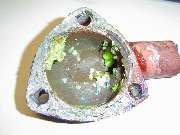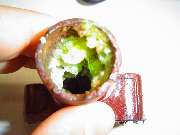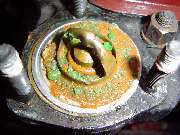The MGA With An Attitude
Do Not Mix OAT's and EG's Antifreeze -- CO-121
Here is a lesson someone learned the hard way. Do not mix OAT antifreeze with Ethylene-Glycol antifreeze. End result can be this jelly like substance that can gum up the works in your cooling system, possibly clogging the heater core and radiator. That might be end of tech session if you could believe me and the pictures, but it leads to a longer discussion of antifreeze types and what may be good or bad for your vintage car.



 Photos supplied by Richard Meyers Photos supplied by Richard Meyers
On 3/9/2012, Richard Meyers wrote:
"I found some jelled coolant, and don't know what it is from. The radiator
core was replaced last year and I am not sure what they used or put in with the coolant. I have flushed out the radiator and the block and head have now been hot tanked. Do you think I have any cause for concern"?
The most common older type antifreeze is Ethylene-Glycol (which is toxic) and water (EGW). There is also Propylene-Glycol (which itself is non-toxic and is used as a food additive) and water (PGW). The more modern antifreeze is Organic Acid Technology (OAT) which is commonly touted as being non-toxic and environmentally friendly. The most well known brand name for OAT antifreeze is "Dexcool". A problem with any automotive antifreeze is in the anti-corrosion additives, about 5% of the solution, which are toxic. The anti-corrosion additives are needed to prevent galvanic corrosion of dissimilar metals in the cooling system. The glycol compounds are very long lived. It is the anti-corrosion additive components that degrade with time to limit useful life of the antifreeze. This is why EGW and PGW need to be changed every two years, and OAT needs to be changed every five years.
The jelled coolant is a result of mixing two different types of antifreeze, and additional exposure to air. If you top up with OAT without flushing out the EGW you get the goo. This is aggravated by a non-sealed cooling system with air inside the radiator, as air reacts badly with the OAT coolant. If you are going to use OAT for coolant the car needs to have a sealed radiator with an external expansion tank to assure there will never be air in the radiator.
Some people report that the jelled goo may be difficult to remove from the cooling system. Other people report that the issue was resolved by standard technique chemical flushing of the cooling system and rinse with lots of clean water, and they had no residual cooling problems for long term. Perhaps some people are luckier than others, or maybe it's easier to clean out when done early. Since you just had the head and block hot tanked, you will likely be okay. I suggest you back flush the heater core and radiator, and be sure they flow freely. If there are any clogs in the radiator you might feel cool spots on the core while running. Radiator and heater core can also be hot tanked (boiled out) by a local radiator shop.
In any case, I would never put OAT coolant in a vintage car with vented cooling system. The OAT stuff, aside from being long life, is intended for use in cars with lots of dissimilar metals in the cooling system, like an iron engine block, aluminum cylinder head, aluminum radiator, steel or copper head gasket, and sealed cooling systems. The standard 2-year green stuff (EGW) works well in vintage cars with iron engine, copper radiator and vented cooling system. OAT may not be worth the risk just to extend fluid change from 2 year to 5 year intervals.
|